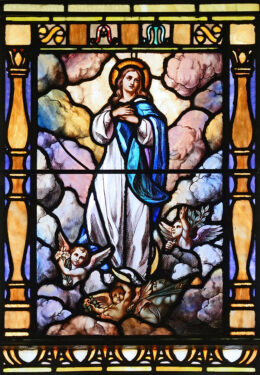My dear brothers and sisters in the Lord,
Recently I read an article regarding icons. It is very interesting to understand these images that come from the Eastern tradition and which contain in themselves a unique whole theology. For example, the clothing of Jesus and Mary are represented with the same colors, red and blue, but they are reversed in that Jesus usually has a red tunic and a blue mantle while Our Lady usually has a blue dress and a red mantle. Why, you might ask? The red is a symbol of divinity, while blue is a symbol of humanity. In this way, it can be said that Jesus is God made man, while Our Lady instead is a human creature that has been in a certain sense divinized.

Again, while Jesus is represented with His feet uncovered placed directly on the earth, Our Lady instead has shoes which she has placed lightly on her feet. This expresses the same concept, in that Jesus is the Word of God incarnate, true man like us in all things except sin, while Our Lady is a human creature through and through because by supernatural grace and her faithful response to grace she is raised above the earth.
Truly, icons are wonderful works of art. Some have called them windows into heaven because they so clearly express spiritual and theological truths that become schools of Christian learning. Next week, we celebrate the feast of Our Lady assumed into heaven at the end of her earthly life. In icons, Mary’s Assumption is depicted as her Dormition, Mary falling asleep in the Lord. This special privilege conceded by God by exception is an anticipation of the ultimate destiny of all humankind. We know that God has conceded this privilege to her because she was conceived without sin.
Because of her Immaculate Conception, her body did not have to undergo the corruption of death. Therefore, as the Church has always taught, Mary was assumed bodily into Heaven. She continues to make intercession for us, we who are her children. Mary recognizes that we always need her as our mother and intercessor before the throne of God.
Mary’s Assumption is the second pledge, after the Resurrection of Jesus Himself, of our own bodily resurrection someday. We recite this every Sunday in the Creed, however, do we know what it means? Some day in the future, the bodily resurrection of those who have died will occur, when Christ becomes all-in-all, when He brings everything back together again.
The Assumption of Mary gives us an insight into her whole life. She who was privileged to be conceived without sin receives the full blessing of that sinless life by being assumed body and soul into heaven. This ancient dogma of the Church, most recently defined by Pius XII in 1950, reminds us also of our own promise of glory as we will someday not only experience the fruits of the resurrection but also share the glory of heaven in God’s plan and in His good time.
Tradition has it that a special blessing is available on the Feast of the Assumption for those who wade into the water or use the water blessed on that day. Certainly, water is the symbol of our regeneration in Baptism and ordinary water with the blessing of the Church has the power to accomplish miracles. Lest we believe in some superstitious way that water has miraculous power on this day, we must always consider the power of blessing.
Blessing derives its origin in the Gospel itself in the life of Jesus who constantly blessed children, the sick, the paralyzed, or anyone who came to Him. He most probably invoked the “brekot” blessings of the Hebrew tradition, wherein God is praised as the Lord of creation, and His creatures invoke His blessing that they might ever be closer to the Creator and His original purpose.
In the spirit of the Feast of the Assumption of our Blessed Mother, we seek Mary’s intercession as the Mother of all people to show us the way to put out into the deep waters of understanding and acceptance of all people as our brothers and sisters.
